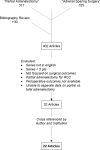Partial adrenalectomy: underused first line therapy for small adrenal tumors
- PMID: 20546805
- PMCID: PMC3164765
- DOI: 10.1016/j.juro.2010.03.052
Partial adrenalectomy: underused first line therapy for small adrenal tumors
Abstract
Purpose: Many patients with small adrenal masses undergo total adrenalectomy. We evaluated partial adrenalectomy outcomes by performing a comprehensive literature review.
Materials and methods: We performed a PubMed search of the English language literature using the queries partial adrenalectomy and adrenal sparing surgery, and identified 317 and 155 articles, respectively. We excluded case reports or series with fewer than 5 patients, articles not focused on surgical management and those that did not indicate perioperative outcomes. The remaining articles were cross-referenced by author and institution to eliminate studies with redundant cases. Demographics, diagnosis, tumor characteristics, perioperative and functional outcomes, and recurrence data were collected when available.
Results: A total of 22 articles from a total of 22 first authors met our inclusion criteria, describing outcomes in a total of 417 patients. There has been an increasing trend toward partial adrenalectomy worldwide in the last 20 years. Partial adrenalectomy is most commonly done for Conn's syndrome, followed by pheochromocytoma. Most procedures are laparoscopic with minimal morbidity. The recurrence rate is only 3% and more than 90% of patients remain steroid independent.
Conclusions: Partial adrenalectomy surgical outcomes and perioperative complications are similar to those reported for total adrenalectomy. When partial adrenalectomy is done for small adrenal lesions, the malignancy rate is negligible, the recurrence rate is low and most patients remain steroid-free at long-term followup. These data strongly support the acceptance of partial adrenalectomy as first line treatment for small adrenal masses.
Figures
References
-
- Lupo J. Trends in adrenal surgery and adrenal cancer incidence and survival in the era of laparoscopic surgery. Journal of the American College of Surgeons. 2008;207:S79.
-
- Mantero F, Terzola M, Arnaldi G, et al. A Survey on Adrenal Incidentaloma in Italy. Journal of Clinical Endocrinology & Metabolism. 2000;85:637. - PubMed
-
- Castillo OA, Vitagliano G, Cortes O, et al. Bilateral laparoscopic adrenalectomy. J Endourol. 2007;21:1053. - PubMed
-
- Diner EK, Franks ME, Behari A, et al. Partial adrenalectomy: the National Cancer Institute experience. Urology. 2005;66:19. - PubMed
-
- Edstrom E, Grondal S, Norstrom F, et al. Long term experience after subtotal adrenalectomy for multiple endocrine neoplasia type IIa. Eur J Surg. 1999;165:431. - PubMed
Publication types
MeSH terms
Grants and funding
LinkOut - more resources
Full Text Sources
Medical
Miscellaneous




